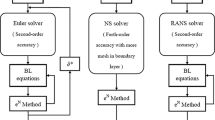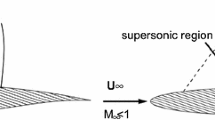Abstract
Based on the supercritical “wing1” which was released in the DPW-III conference, multi-objective optimization has been done to increase the lift-drag ratio at cruise condition and improve transonic buffet boundary and drag-rise performance. Hicks-Henne shape functions are used to represent the bump shape. In the design optimization to increase lift-drag ratio, the objectives involve the cruise point and three other off-design points nearby. In the other optimization process to improve buffet and drag-rise performance, three buffet onset points near the cruise point and one drag-rise point are selected as the design points. Non-dominating sort genetic algorithm II (NSGA-II) is used in both processes. Additionally, individual analysis for every selected point on the Pareto frontier is conducted in order to avoid local convergence and achieve global optimum. Results of optimization for aerodynamic efficiency show a decrease of 11 counts in drag at the cruise point. Drag at nearby off-design points are also reduced to some extent. Similar approaches are made to improve buffet and drag-rise characteristics, resulting in significant improvements in both ways.
Similar content being viewed by others
References
Tian Y, Liu P. Supercritical wing design of the large aircraft. Inter Avia, 2010, 4: 54–56
Wagner O. The supercritical profile of the supercritical wing. NASA-TM-76605, 1981
Harris C D. NASA supercritical airfoils. NASA Technical Paper 2969, 1990
Schrauf G. Key aerodynamic technologies for aircraft performance improvement. Fifth Community Aeronautical Days, Austria, 2006
Anders S G, Sellers W L, Washburn A E. Active flow control activities at NASA langley. AIAA 2004-2623, 2004
Rosemann H. Wave drag reduction concepts for transonic wings. European Congress on Computational nethods in Applied Sciences and Engineering. Jyvaskyla, Finland, ECCOMAS 2004
Bahi L, Ross J M, Nagamatsu H T. Passive shock wave boundary layer control for transonic airfoil drag reduction. AIAA 83-0137, 1983
Ashill P R, Fulker J L, Shires A J. A novel technique for ontrolling shock strength of laminar-flow aerofoil sections. First European Forum on Laminar Flow Technology, Hamburg, Germany, 1992, 175–183
Nagamatsu H T, Orozco R D, Ling D C. Porosity effect on supercritical airfoil drag reduction by shock wave/boundary layer control. AIAA 84-1682, 1984
Hartwich P M. Euler study on porous transonic airfoils with a view toward multipoint design. AIAA 91-3286, 1991
Hartwich P M, Mineck R E. Experimental study on porous transonic airfoils with a view toward multipoint design. AIAA 94-0500, 1994
Fulker J L. The EUROSHOCK programme (A european programme on active and passive control of shock waves). AIAA 99-3174, 1999
Stanewsky E. Drag reduction by shock and boundary layer control: Results of the project EUROSHOCK II supported by the European Union, 1996–1999. Notes on Numerical Fluid Mechanics and Multidisciplinary Design, Vol. 80. New York: Springer, 2002
Qin N, Zhu Y, Ashill P. Active control of transonic aerodynamics using suction, blowing, bumps and synthetic jets. AIAA 2000-4329, 2000
Dima C, deMatteis P. Effects of shock and boundary-layer control techniques on transonic flows about airfoils. AIAA 2000-0517, 2000
Wadehn W, Sommerer A, Lutz Th. Structural concepts and aerodynamic design of shock control bumps. Proceedings of the 23rd International Congress of the Aeronautical Sciences, Toronto, Canada, 2002: 66R1
Smith A N, Babinsky H, Fulker J L. Control of normal shock wave/turbulent boundary-layer Interaction using streamwise slots. AIAA 2001-0739, 2001
Lu F K, Li Q, Shih Y. Review of micro vortex generators in high-speed flow. AIAA 2011-31, 2011
Gietz G, Passive shock control concept for drag reduction in transonic flow. J Aircraft, 2005, 42: 794–798
Schulein E. Shock-wave control by permeable wake generators. AIAA 2010-4977, 2010
Holden H A, Babinsky H. Shock/Boundary layer interaction control using 3D devices. AIAA 2003-447, 2003
Richter K, Rosemann H. Experimental investigation of trailing-edge devices at transonic speeds. The Aeronautical J of the Royal Aeronautical Society, 2002, 106: 185–193
Ogawa H, Babinsky H. Shock/boundary-layer interaction control using three-dimensional bumps for transonic wings. AIAA 2007-324, 2007
Eastwood J P, Jarrett J P. Towards designing with 3D bumps for wing drag reduction. AIAA 2011-1168, 2011
Tian Y, Liu P, Feng P. Shock control bump parametric research on supercritical airfoil. Sci China Tech Sci, 2011, 11: 2935–2944
Zingg D W, Diosady L, Billing L. Adaptive airfoils for drag reduction at transonic speeds. AIAA 2006-3656, 2006
Kutzbach M, Lutz T. Investigations on shock control bumps for infinite swept wings. AIAA 2004-2702, 2004
Tian Y, Liu P, Peng J. Using shock control bump to improve transonic buffet boundary of airfoil. Acta Aeronautica et Astronaut Sinica, 2011, 32: 1421–1428
Millholen W E, Owens L R. On the application of contour bumps for transonic drag reduction (Invited). AIAA 2005-462, 2005
Author information
Authors and Affiliations
Corresponding author
Rights and permissions
About this article
Cite this article
Tian, Y., Liu, P. & Li, Z. Multi-objective optimization of shock control bump on a supercritical wing. Sci. China Technol. Sci. 57, 192–202 (2014). https://doi.org/10.1007/s11431-013-5410-3
Received:
Accepted:
Published:
Issue Date:
DOI: https://doi.org/10.1007/s11431-013-5410-3




